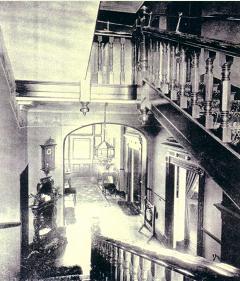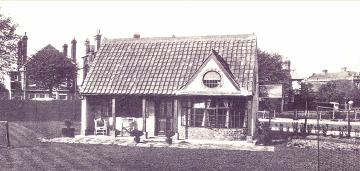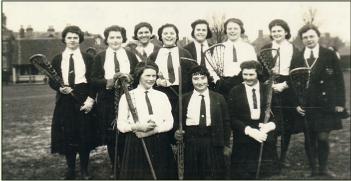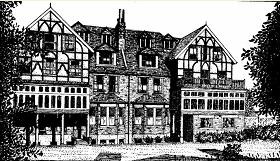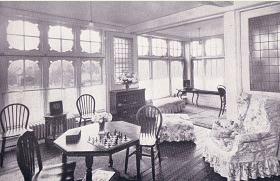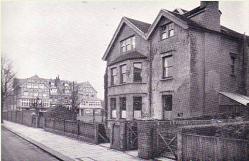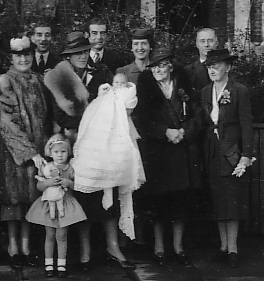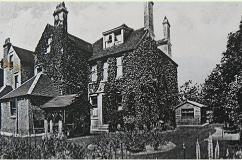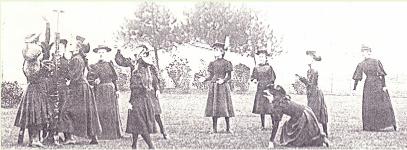Chapter 2
1922 - 1939
The nieces, the Misses de la Mare
When Miss de la Mare died, the three nieces inherited the school. Miss Marguerite came home after fifteen years abroad to take up the role of Principal and was known as Miss de la Mare. Her sisters, Miss Guilbert and Miss Kathleen, became joint Vice-Principals. Thus began a new era in September 1922. The three sisters differed from each other, both in appearance and in character.
MARGUERITE, THE NEW MISS DE LA MARE
Miss de la Mare taught some senior French but her main duties were the welfare of the boarders, housekeeping, interviewing parents and organising stage performances at Christmas in the Pleasure Gardens Theatre in aid of the Mayor's Coal Fund.
Ursula Lock, 1925-28, remembers her as "small, thin, with a yellowish complexion, rather friendly when we had any dealings with her, and dressed, at times such as prize giving, with regard to fashion - low waisted, short silk dresses. We did not see much of her except at some meals when she sat at the head of the boarders' table for Saturday lunch or sometimes at supper." Sonia Speich, 1938-39, recalls Miss de la Mare as "austere, pale complexioned, pince-nez on her nose, her grey hair drawn back in a bun and clothes of a sombre hue." Sonia is seen in the 1938 school photograph on page xxx sitting cross-legged on the far left.
My mother, Ruby Gordon, had been at the school during the aunt's time, but when she returned to the school in 1930, ten years after her marriage, meeting the eldest niece brought back memories of the aunt. "I went to interview Miss Marguerite to ask her to accept my daughter Amber as a pupil. The dreaded drawing room reminded me instantly of recurring misdemeanours resulting in being summoned to the Head, and I began to respond to her questions with the old routine of 'Yes, Miss de la Mare,' and 'No, Miss de la Mare', until I suddenly thought 'Gracious, it is I who can lay down the law and tell her what I want my daughter to do!' Amber told me that when she had been particularly naughty, the Dellies used to say 'Your mother never would have done such a thing. She was such a good little girl.' Time is a great healer."
Between 1926 and 1939 Miss de la Mare took parties of girls on annual visits abroad by boat and train: to the Channel Islands, Normandy, Belgium, Italy, Greece, Germany - including the Oberammergau Passion Play - and for winter sports to Saas Fee in Switzerland. At a 'Cheerful Sparrows' charity fête in August 1929 the Principal won an Austin Seven 'Touring' car, called it The Sparrow and learned to drive. Like her aunt, she was called Delly behind her back, and in later years many of the girls spelt this 'Delhi'.
MISS GUILBERT
Miss Guilbert was known by the girls as either 'Gilly', 'Gilly-Bird' or 'G.B.' She not only taught gym and games but also drawing, senior arithmetic and French. She was responsible for the school accounts, and worked with Miss Kathleen to prepare the time-table. The girls remember her now with a variety of emotions, depending on whether they had been among her favourites or had struggled to meet her expectations of them. Sonia Speich compares Miss Guilbert with her elder sister and remembers her as "more volatile and frightening, having a sharp tongue. She wore her hair in a bun, and round her neck a narrow black velvet band." Ursula Lock remembers that the girls always knew when there was going to be a row over some misdemeanour, because it was preceded by the singing of the hymn "O Jesus, I have promised". Miss Guilbert had a series of pekinese dogs, one after the
other, and called them all Toto. Toto III was a good-natured little dog with a beautiful coat,
who let the girls pull him about and never snapped.There are memories of a "frightful peke"
who "stank" but this may have been one of his predecessors.
MISS KATHLEEN
Miss Kathleen was teaching at Tonbridge County School for Girls when her aunt died, and left a few years later in 1928 to join her sisters at St Margaret's where she taught throughout the school, including geography, English, scripture and junior arithmetic, and supervised the teaching staff. She was quiet and dignified and kept perfect order in the classroom without apparent effort. My aunt, Ivy Gordon, recalled that one could hear a pin drop during Miss Kathleen's lessons. The library was in her charge and she encouraged the girls to do a lot of reading after their Oxford Local Examinations were over. One evening Ursula Lock was reading in the library with a few other girls when Miss Kathleen entered and surprised them by saying: "Now, I wonder if any of you will become famous?" (Ursula Lock later married the composer Ralph Vaughan-Williams and wrote his biography.) Miss Kathleen and Miss Guilbert both collected stamps and were members of the Cinque Ports Philatelic Society. According to the author's sister Amber, Miss Kathleen was in love with two men, Sir Anthony Eden and St.Paul.





